Modernization Theory
VerifiedAdded on 2023/01/17
|8
|1608
|67
AI Summary
Modernization theory refers to the process of modernization and development in society. It evaluates internal factors for social progress and development. This paper discusses various central theories and approaches to international development.
Contribute Materials
Your contribution can guide someone’s learning journey. Share your
documents today.
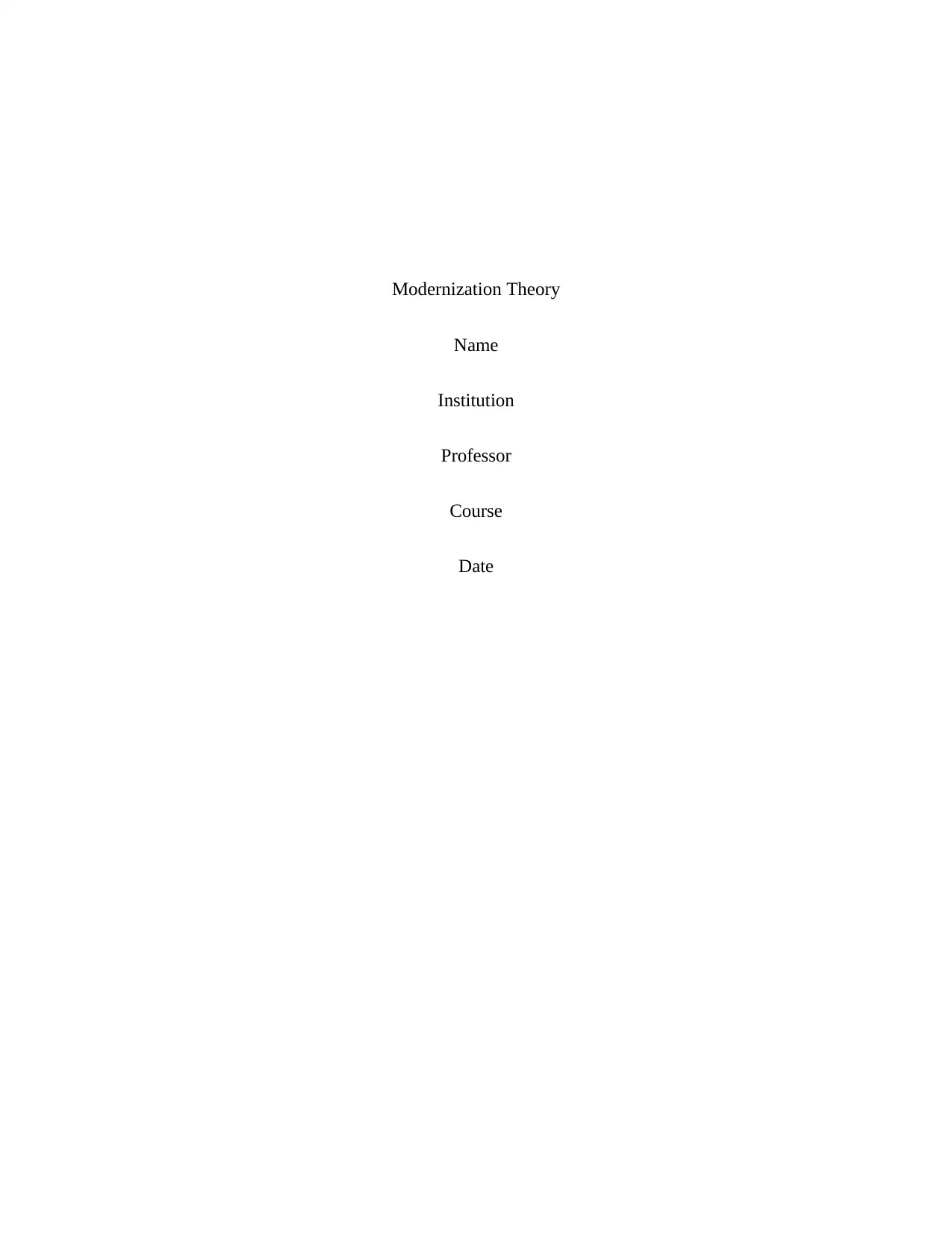
Modernization Theory
Name
Institution
Professor
Course
Date
Name
Institution
Professor
Course
Date
Secure Best Marks with AI Grader
Need help grading? Try our AI Grader for instant feedback on your assignments.

Modernization theory
This refers to a particular theory that is used to indicate the procedure of modernization and
development in various perspective within the society. This particular theory evaluates internal
factors of a nation while having the perspective that the less developed states have the capability
to continuously develop.(Henry,1971). Modernization theory tries to indicate the available social
variables that ensure tremendous social progress and the development of the contemporary
society while attempting to discuss the procedure existing of social revolution. This paper
discusses various theories.
Over the years this particular theory have been a huge subject of critics who are mainly socialist,
systems theorist,globalization,dependency hypothesis and distinct ideologies from free
market.conversely,it emphasizes on the required process of change and the immediate response
resulting from the same change (Hicks & Streeten,1979). Modernization theory is also
significant since it highlights an internal dynamics while stressing mainly on other social and
cultural sub structures and also adapting advanced technologies across the global domain.
Therefore this paper attempts to critically discuss various central theories and approaches to
international development.
Rostow's model of economic development
This theory is one of the structuralism approaches regarding economic development.Rostow’s
principle postulation is that it is intelligent and basically conceivable to identify stages of
improvement to characterize society as indicated by those stages. Whereby he distinguished the
steps by thinking about profitable limit and innovation, fabricating industry, transport and
sparing contributing and exchange, these stage are as per the following;- Traditional society, this
This refers to a particular theory that is used to indicate the procedure of modernization and
development in various perspective within the society. This particular theory evaluates internal
factors of a nation while having the perspective that the less developed states have the capability
to continuously develop.(Henry,1971). Modernization theory tries to indicate the available social
variables that ensure tremendous social progress and the development of the contemporary
society while attempting to discuss the procedure existing of social revolution. This paper
discusses various theories.
Over the years this particular theory have been a huge subject of critics who are mainly socialist,
systems theorist,globalization,dependency hypothesis and distinct ideologies from free
market.conversely,it emphasizes on the required process of change and the immediate response
resulting from the same change (Hicks & Streeten,1979). Modernization theory is also
significant since it highlights an internal dynamics while stressing mainly on other social and
cultural sub structures and also adapting advanced technologies across the global domain.
Therefore this paper attempts to critically discuss various central theories and approaches to
international development.
Rostow's model of economic development
This theory is one of the structuralism approaches regarding economic development.Rostow’s
principle postulation is that it is intelligent and basically conceivable to identify stages of
improvement to characterize society as indicated by those stages. Whereby he distinguished the
steps by thinking about profitable limit and innovation, fabricating industry, transport and
sparing contributing and exchange, these stage are as per the following;- Traditional society, this
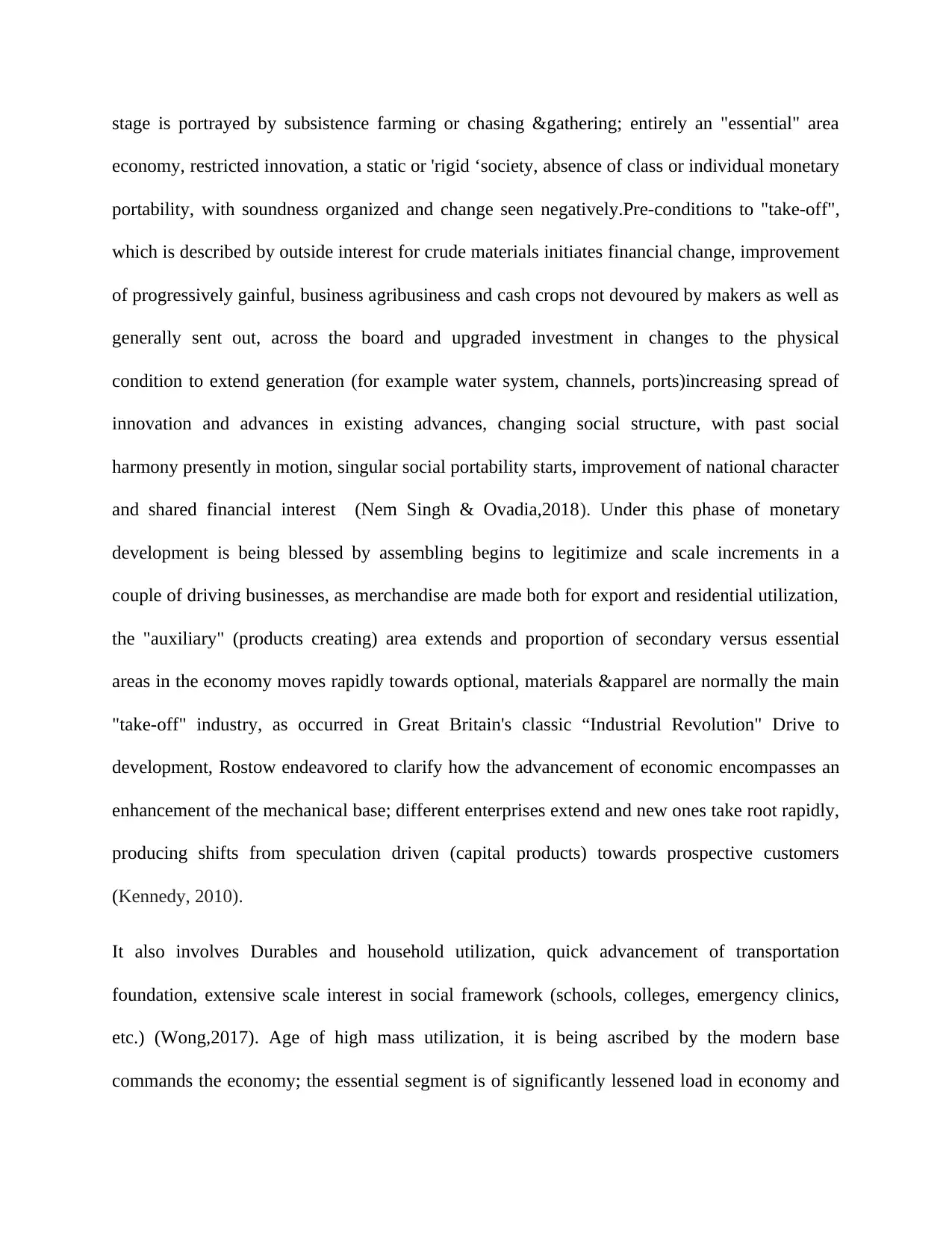
stage is portrayed by subsistence farming or chasing &gathering; entirely an "essential" area
economy, restricted innovation, a static or 'rigid ‘society, absence of class or individual monetary
portability, with soundness organized and change seen negatively.Pre-conditions to "take-off",
which is described by outside interest for crude materials initiates financial change, improvement
of progressively gainful, business agribusiness and cash crops not devoured by makers as well as
generally sent out, across the board and upgraded investment in changes to the physical
condition to extend generation (for example water system, channels, ports)increasing spread of
innovation and advances in existing advances, changing social structure, with past social
harmony presently in motion, singular social portability starts, improvement of national character
and shared financial interest (Nem Singh & Ovadia,2018). Under this phase of monetary
development is being blessed by assembling begins to legitimize and scale increments in a
couple of driving businesses, as merchandise are made both for export and residential utilization,
the "auxiliary" (products creating) area extends and proportion of secondary versus essential
areas in the economy moves rapidly towards optional, materials &apparel are normally the main
"take-off" industry, as occurred in Great Britain's classic “Industrial Revolution" Drive to
development, Rostow endeavored to clarify how the advancement of economic encompasses an
enhancement of the mechanical base; different enterprises extend and new ones take root rapidly,
producing shifts from speculation driven (capital products) towards prospective customers
(Kennedy, 2010).
It also involves Durables and household utilization, quick advancement of transportation
foundation, extensive scale interest in social framework (schools, colleges, emergency clinics,
etc.) (Wong,2017). Age of high mass utilization, it is being ascribed by the modern base
commands the economy; the essential segment is of significantly lessened load in economy and
economy, restricted innovation, a static or 'rigid ‘society, absence of class or individual monetary
portability, with soundness organized and change seen negatively.Pre-conditions to "take-off",
which is described by outside interest for crude materials initiates financial change, improvement
of progressively gainful, business agribusiness and cash crops not devoured by makers as well as
generally sent out, across the board and upgraded investment in changes to the physical
condition to extend generation (for example water system, channels, ports)increasing spread of
innovation and advances in existing advances, changing social structure, with past social
harmony presently in motion, singular social portability starts, improvement of national character
and shared financial interest (Nem Singh & Ovadia,2018). Under this phase of monetary
development is being blessed by assembling begins to legitimize and scale increments in a
couple of driving businesses, as merchandise are made both for export and residential utilization,
the "auxiliary" (products creating) area extends and proportion of secondary versus essential
areas in the economy moves rapidly towards optional, materials &apparel are normally the main
"take-off" industry, as occurred in Great Britain's classic “Industrial Revolution" Drive to
development, Rostow endeavored to clarify how the advancement of economic encompasses an
enhancement of the mechanical base; different enterprises extend and new ones take root rapidly,
producing shifts from speculation driven (capital products) towards prospective customers
(Kennedy, 2010).
It also involves Durables and household utilization, quick advancement of transportation
foundation, extensive scale interest in social framework (schools, colleges, emergency clinics,
etc.) (Wong,2017). Age of high mass utilization, it is being ascribed by the modern base
commands the economy; the essential segment is of significantly lessened load in economy and
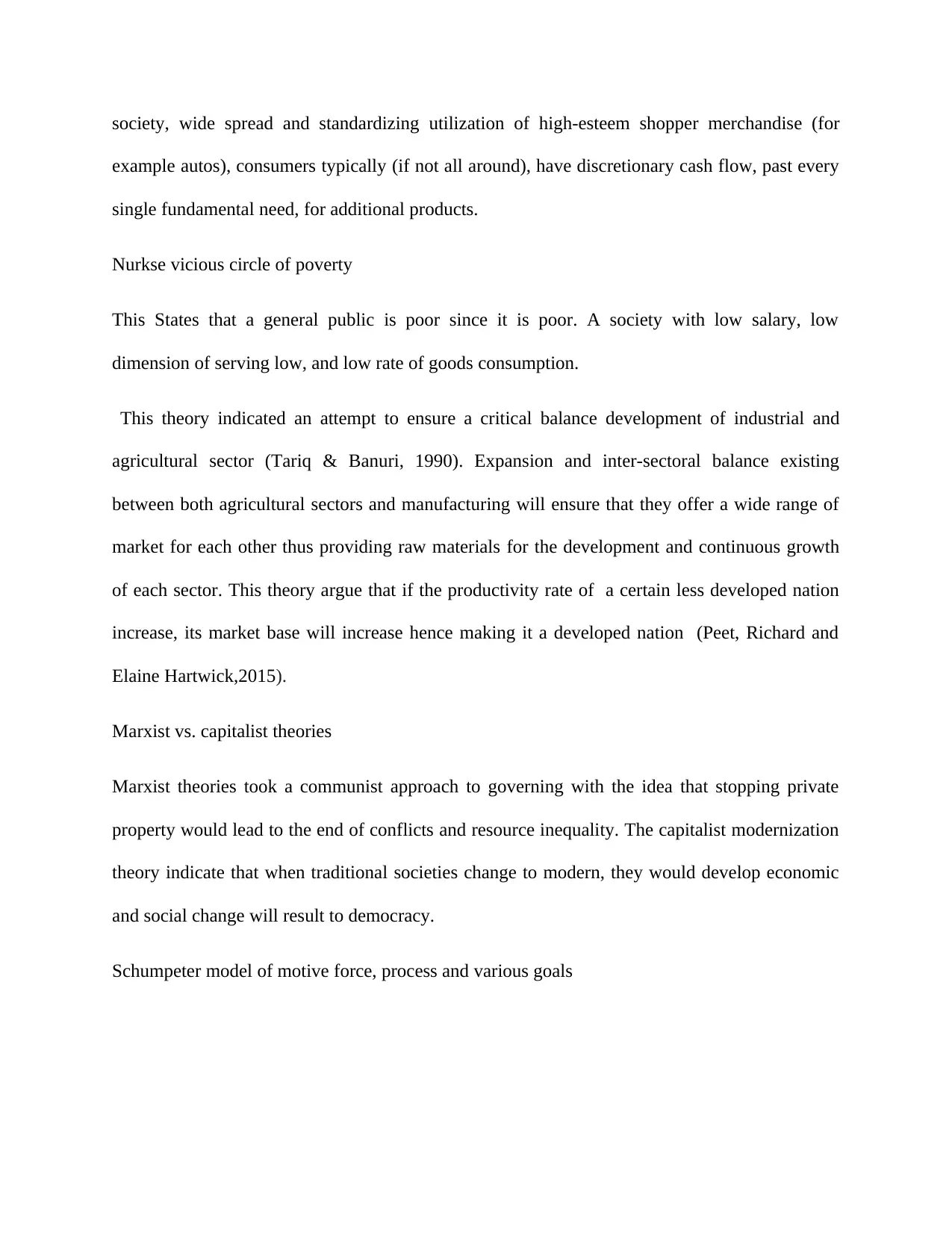
society, wide spread and standardizing utilization of high-esteem shopper merchandise (for
example autos), consumers typically (if not all around), have discretionary cash flow, past every
single fundamental need, for additional products.
Nurkse vicious circle of poverty
This States that a general public is poor since it is poor. A society with low salary, low
dimension of serving low, and low rate of goods consumption.
This theory indicated an attempt to ensure a critical balance development of industrial and
agricultural sector (Tariq & Banuri, 1990). Expansion and inter-sectoral balance existing
between both agricultural sectors and manufacturing will ensure that they offer a wide range of
market for each other thus providing raw materials for the development and continuous growth
of each sector. This theory argue that if the productivity rate of a certain less developed nation
increase, its market base will increase hence making it a developed nation (Peet, Richard and
Elaine Hartwick,2015).
Marxist vs. capitalist theories
Marxist theories took a communist approach to governing with the idea that stopping private
property would lead to the end of conflicts and resource inequality. The capitalist modernization
theory indicate that when traditional societies change to modern, they would develop economic
and social change will result to democracy.
Schumpeter model of motive force, process and various goals
example autos), consumers typically (if not all around), have discretionary cash flow, past every
single fundamental need, for additional products.
Nurkse vicious circle of poverty
This States that a general public is poor since it is poor. A society with low salary, low
dimension of serving low, and low rate of goods consumption.
This theory indicated an attempt to ensure a critical balance development of industrial and
agricultural sector (Tariq & Banuri, 1990). Expansion and inter-sectoral balance existing
between both agricultural sectors and manufacturing will ensure that they offer a wide range of
market for each other thus providing raw materials for the development and continuous growth
of each sector. This theory argue that if the productivity rate of a certain less developed nation
increase, its market base will increase hence making it a developed nation (Peet, Richard and
Elaine Hartwick,2015).
Marxist vs. capitalist theories
Marxist theories took a communist approach to governing with the idea that stopping private
property would lead to the end of conflicts and resource inequality. The capitalist modernization
theory indicate that when traditional societies change to modern, they would develop economic
and social change will result to democracy.
Schumpeter model of motive force, process and various goals
Paraphrase This Document
Need a fresh take? Get an instant paraphrase of this document with our AI Paraphraser
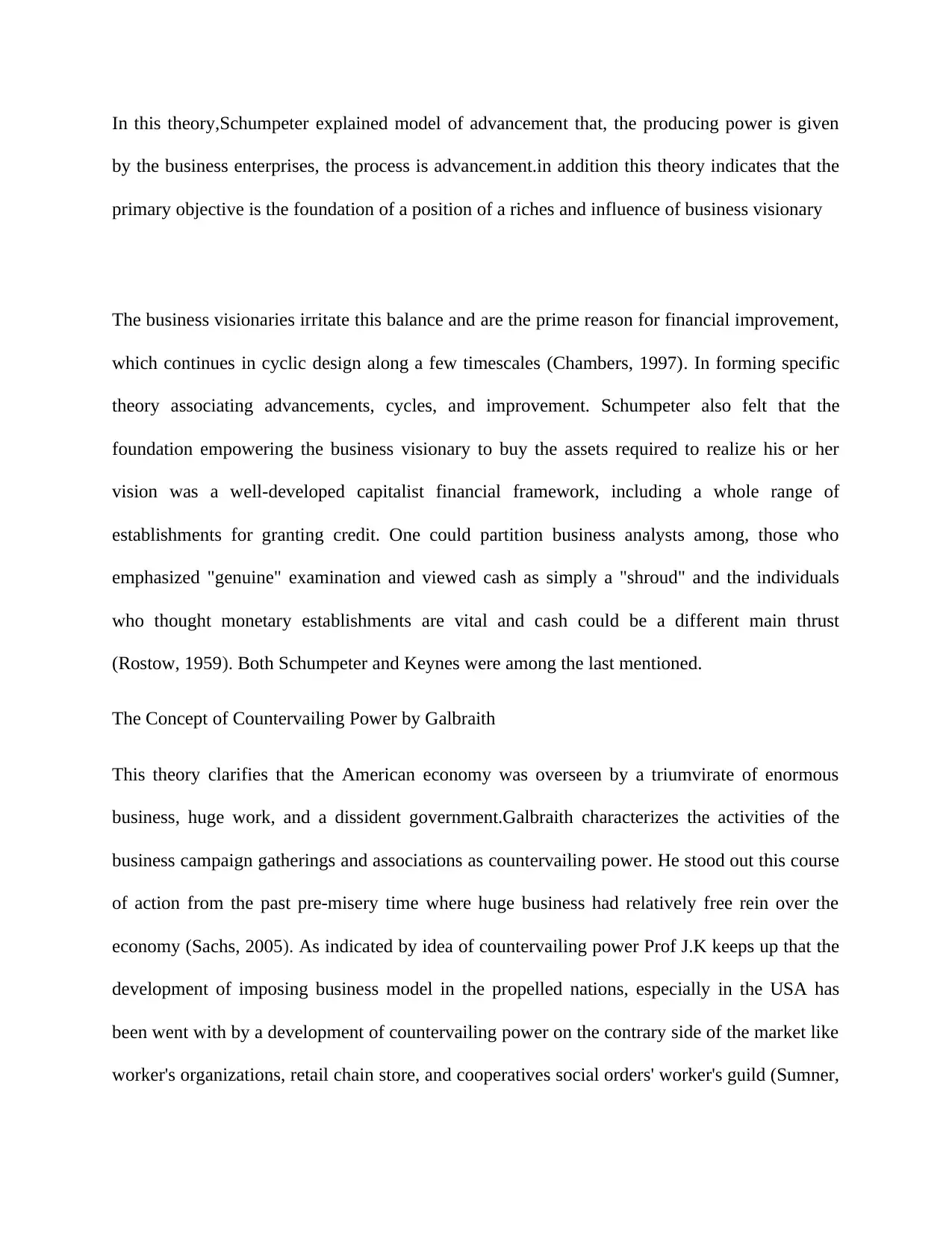
In this theory,Schumpeter explained model of advancement that, the producing power is given
by the business enterprises, the process is advancement.in addition this theory indicates that the
primary objective is the foundation of a position of a riches and influence of business visionary
The business visionaries irritate this balance and are the prime reason for financial improvement,
which continues in cyclic design along a few timescales (Chambers, 1997). In forming specific
theory associating advancements, cycles, and improvement. Schumpeter also felt that the
foundation empowering the business visionary to buy the assets required to realize his or her
vision was a well-developed capitalist financial framework, including a whole range of
establishments for granting credit. One could partition business analysts among, those who
emphasized "genuine" examination and viewed cash as simply a "shroud" and the individuals
who thought monetary establishments are vital and cash could be a different main thrust
(Rostow, 1959). Both Schumpeter and Keynes were among the last mentioned.
The Concept of Countervailing Power by Galbraith
This theory clarifies that the American economy was overseen by a triumvirate of enormous
business, huge work, and a dissident government.Galbraith characterizes the activities of the
business campaign gatherings and associations as countervailing power. He stood out this course
of action from the past pre-misery time where huge business had relatively free rein over the
economy (Sachs, 2005). As indicated by idea of countervailing power Prof J.K keeps up that the
development of imposing business model in the propelled nations, especially in the USA has
been went with by a development of countervailing power on the contrary side of the market like
worker's organizations, retail chain store, and cooperatives social orders' worker's guild (Sumner,
by the business enterprises, the process is advancement.in addition this theory indicates that the
primary objective is the foundation of a position of a riches and influence of business visionary
The business visionaries irritate this balance and are the prime reason for financial improvement,
which continues in cyclic design along a few timescales (Chambers, 1997). In forming specific
theory associating advancements, cycles, and improvement. Schumpeter also felt that the
foundation empowering the business visionary to buy the assets required to realize his or her
vision was a well-developed capitalist financial framework, including a whole range of
establishments for granting credit. One could partition business analysts among, those who
emphasized "genuine" examination and viewed cash as simply a "shroud" and the individuals
who thought monetary establishments are vital and cash could be a different main thrust
(Rostow, 1959). Both Schumpeter and Keynes were among the last mentioned.
The Concept of Countervailing Power by Galbraith
This theory clarifies that the American economy was overseen by a triumvirate of enormous
business, huge work, and a dissident government.Galbraith characterizes the activities of the
business campaign gatherings and associations as countervailing power. He stood out this course
of action from the past pre-misery time where huge business had relatively free rein over the
economy (Sachs, 2005). As indicated by idea of countervailing power Prof J.K keeps up that the
development of imposing business model in the propelled nations, especially in the USA has
been went with by a development of countervailing power on the contrary side of the market like
worker's organizations, retail chain store, and cooperatives social orders' worker's guild (Sumner,
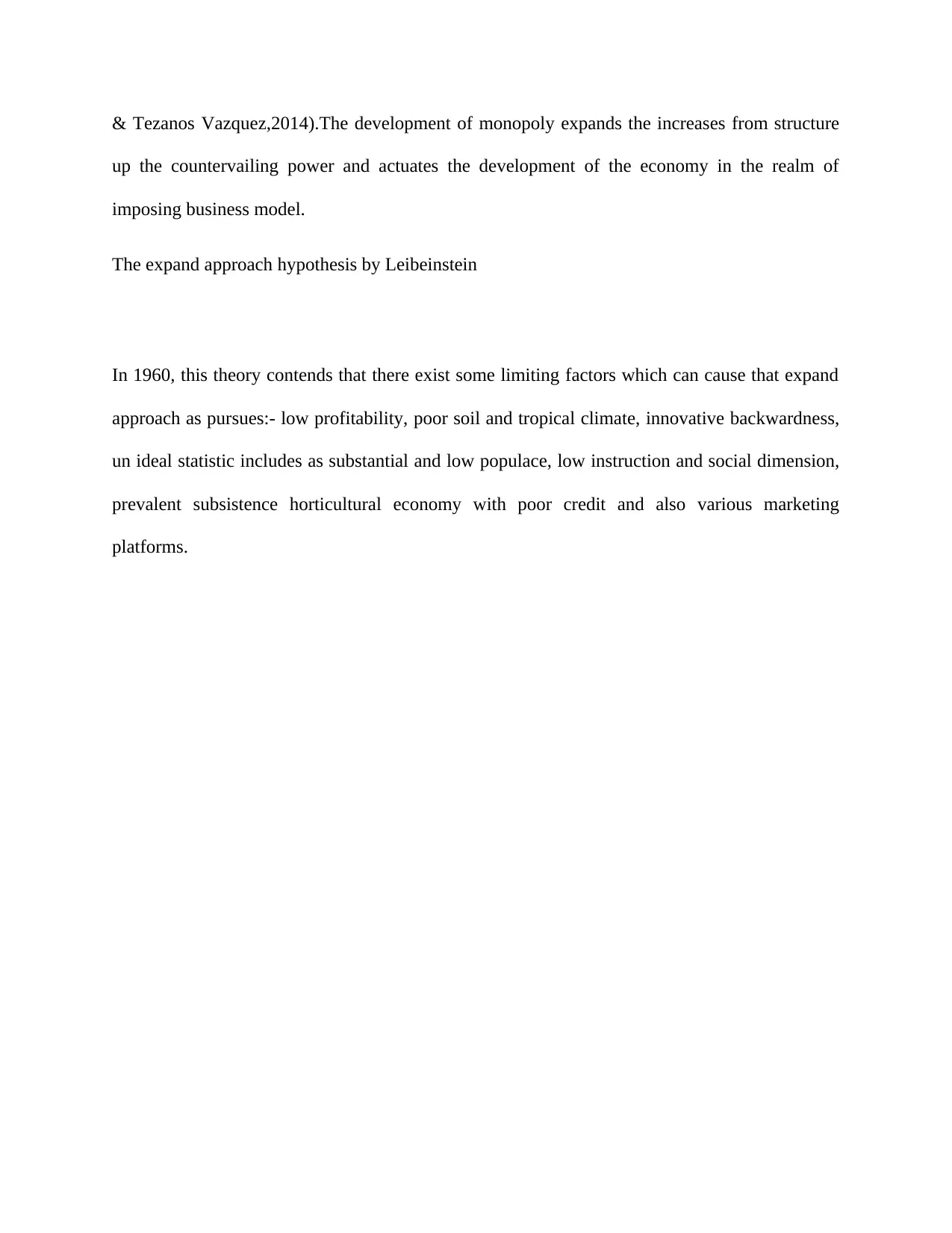
& Tezanos Vazquez,2014).The development of monopoly expands the increases from structure
up the countervailing power and actuates the development of the economy in the realm of
imposing business model.
The expand approach hypothesis by Leibeinstein
In 1960, this theory contends that there exist some limiting factors which can cause that expand
approach as pursues:- low profitability, poor soil and tropical climate, innovative backwardness,
un ideal statistic includes as substantial and low populace, low instruction and social dimension,
prevalent subsistence horticultural economy with poor credit and also various marketing
platforms.
up the countervailing power and actuates the development of the economy in the realm of
imposing business model.
The expand approach hypothesis by Leibeinstein
In 1960, this theory contends that there exist some limiting factors which can cause that expand
approach as pursues:- low profitability, poor soil and tropical climate, innovative backwardness,
un ideal statistic includes as substantial and low populace, low instruction and social dimension,
prevalent subsistence horticultural economy with poor credit and also various marketing
platforms.
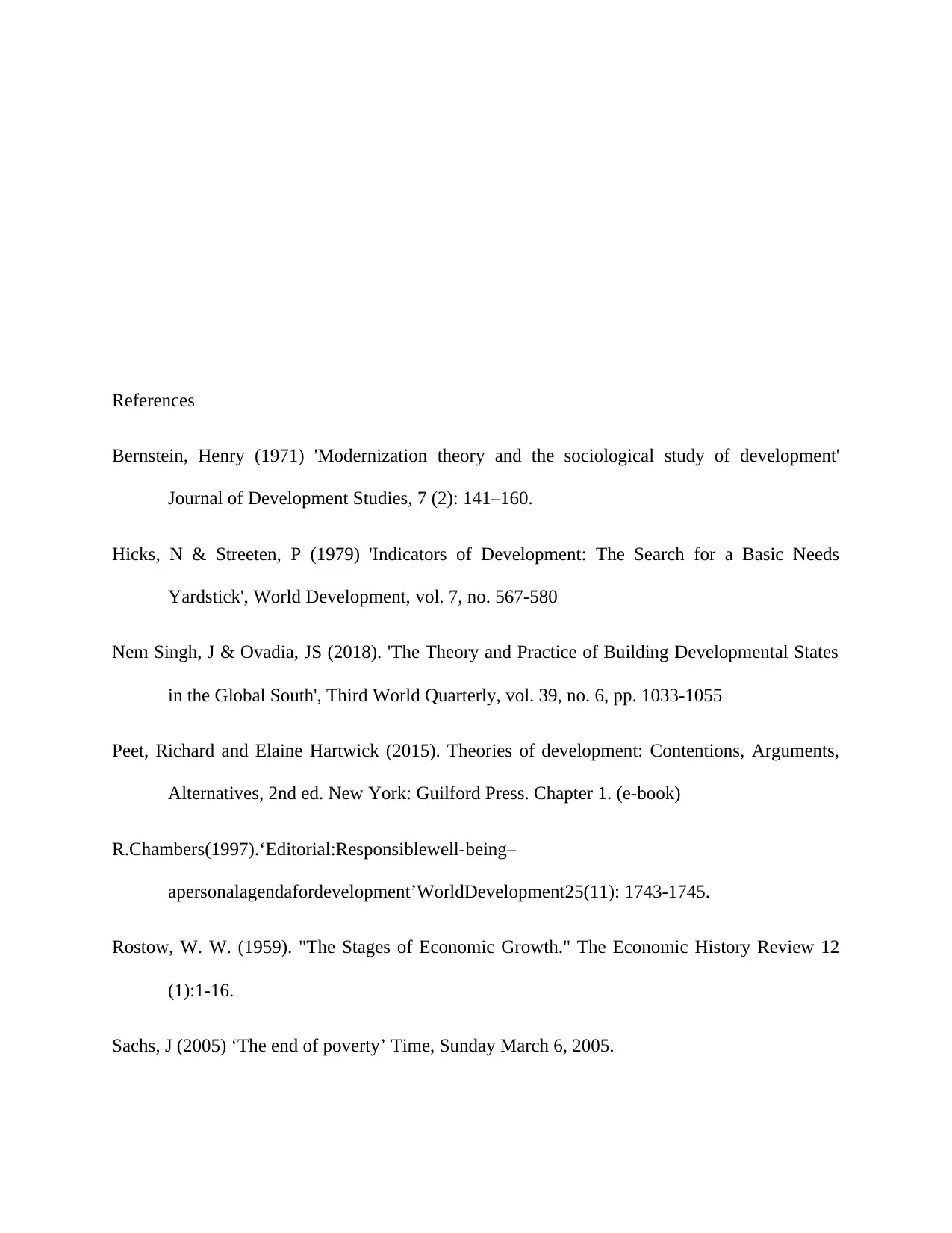
References
Bernstein, Henry (1971) 'Modernization theory and the sociological study of development'
Journal of Development Studies, 7 (2): 141–160.
Hicks, N & Streeten, P (1979) 'Indicators of Development: The Search for a Basic Needs
Yardstick', World Development, vol. 7, no. 567-580
Nem Singh, J & Ovadia, JS (2018). 'The Theory and Practice of Building Developmental States
in the Global South', Third World Quarterly, vol. 39, no. 6, pp. 1033-1055
Peet, Richard and Elaine Hartwick (2015). Theories of development: Contentions, Arguments,
Alternatives, 2nd ed. New York: Guilford Press. Chapter 1. (e-book)
R.Chambers(1997).‘Editorial:Responsiblewell-being–
apersonalagendafordevelopment’WorldDevelopment25(11): 1743-1745.
Rostow, W. W. (1959). "The Stages of Economic Growth." The Economic History Review 12
(1):1-16.
Sachs, J (2005) ‘The end of poverty’ Time, Sunday March 6, 2005.
Bernstein, Henry (1971) 'Modernization theory and the sociological study of development'
Journal of Development Studies, 7 (2): 141–160.
Hicks, N & Streeten, P (1979) 'Indicators of Development: The Search for a Basic Needs
Yardstick', World Development, vol. 7, no. 567-580
Nem Singh, J & Ovadia, JS (2018). 'The Theory and Practice of Building Developmental States
in the Global South', Third World Quarterly, vol. 39, no. 6, pp. 1033-1055
Peet, Richard and Elaine Hartwick (2015). Theories of development: Contentions, Arguments,
Alternatives, 2nd ed. New York: Guilford Press. Chapter 1. (e-book)
R.Chambers(1997).‘Editorial:Responsiblewell-being–
apersonalagendafordevelopment’WorldDevelopment25(11): 1743-1745.
Rostow, W. W. (1959). "The Stages of Economic Growth." The Economic History Review 12
(1):1-16.
Sachs, J (2005) ‘The end of poverty’ Time, Sunday March 6, 2005.
Secure Best Marks with AI Grader
Need help grading? Try our AI Grader for instant feedback on your assignments.
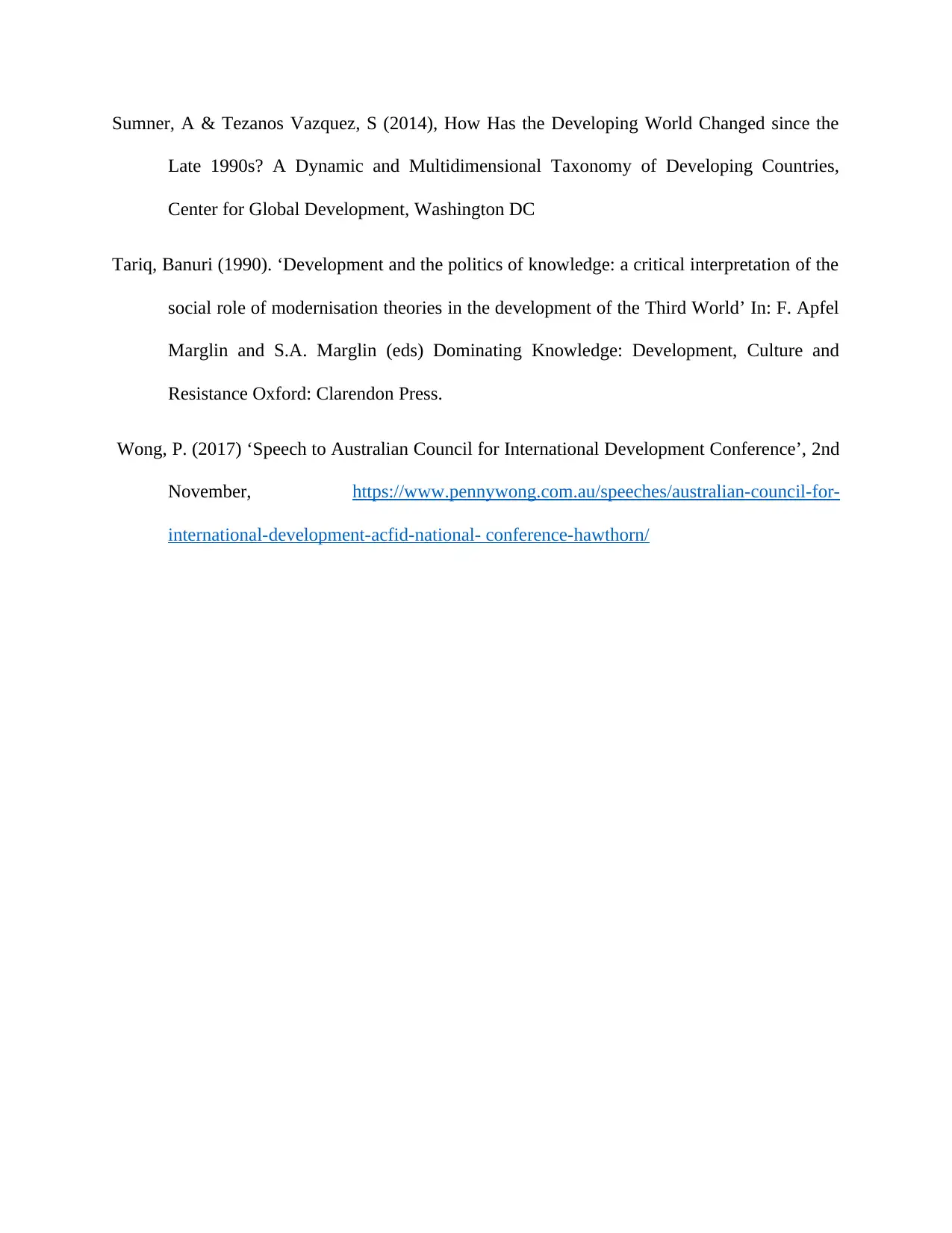
Sumner, A & Tezanos Vazquez, S (2014), How Has the Developing World Changed since the
Late 1990s? A Dynamic and Multidimensional Taxonomy of Developing Countries,
Center for Global Development, Washington DC
Tariq, Banuri (1990). ‘Development and the politics of knowledge: a critical interpretation of the
social role of modernisation theories in the development of the Third World’ In: F. Apfel
Marglin and S.A. Marglin (eds) Dominating Knowledge: Development, Culture and
Resistance Oxford: Clarendon Press.
Wong, P. (2017) ‘Speech to Australian Council for International Development Conference’, 2nd
November, https://www.pennywong.com.au/speeches/australian-council-for-
international-development-acfid-national- conference-hawthorn/
Late 1990s? A Dynamic and Multidimensional Taxonomy of Developing Countries,
Center for Global Development, Washington DC
Tariq, Banuri (1990). ‘Development and the politics of knowledge: a critical interpretation of the
social role of modernisation theories in the development of the Third World’ In: F. Apfel
Marglin and S.A. Marglin (eds) Dominating Knowledge: Development, Culture and
Resistance Oxford: Clarendon Press.
Wong, P. (2017) ‘Speech to Australian Council for International Development Conference’, 2nd
November, https://www.pennywong.com.au/speeches/australian-council-for-
international-development-acfid-national- conference-hawthorn/
1 out of 8
![[object Object]](/_next/static/media/star-bottom.7253800d.svg)





